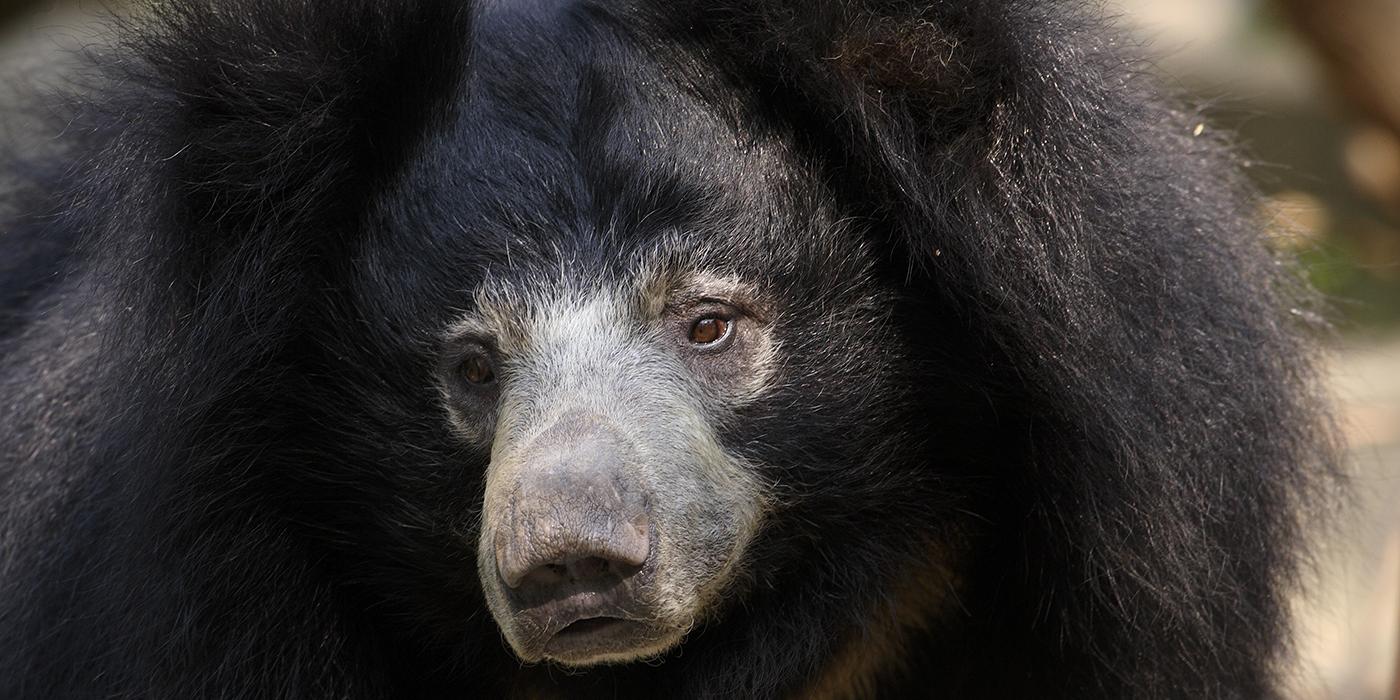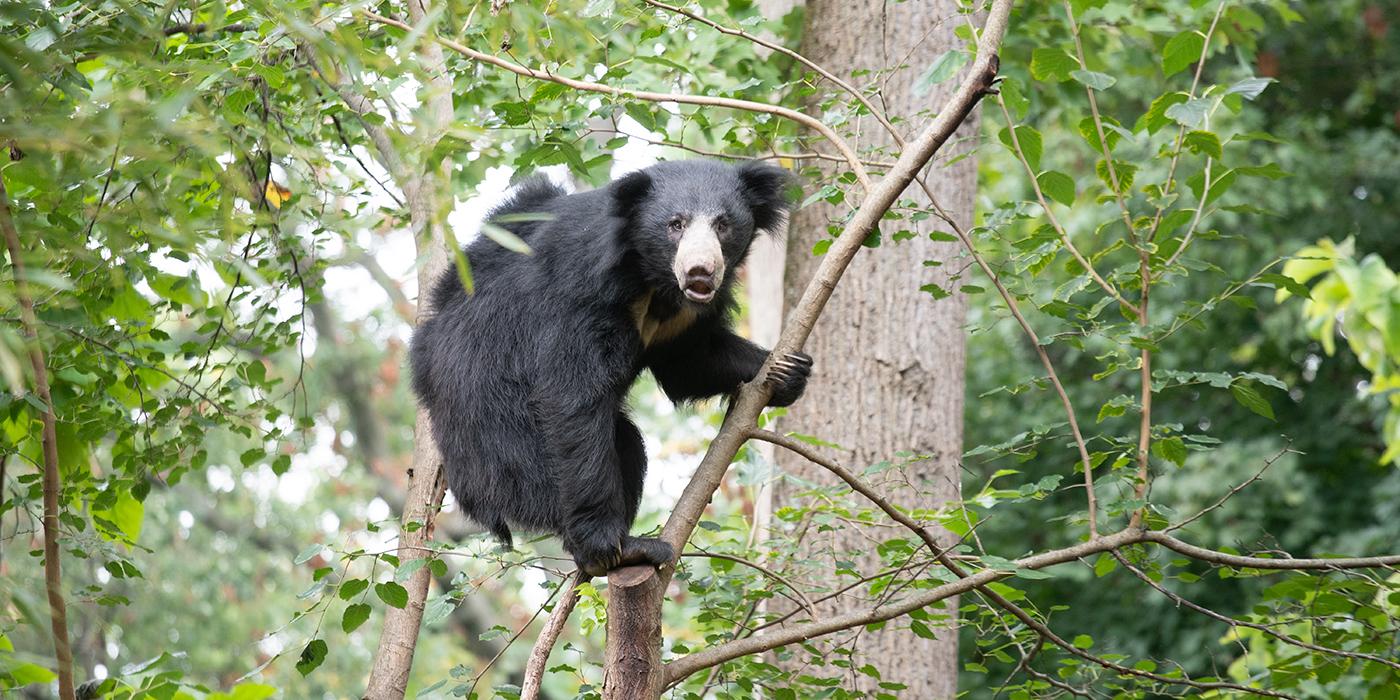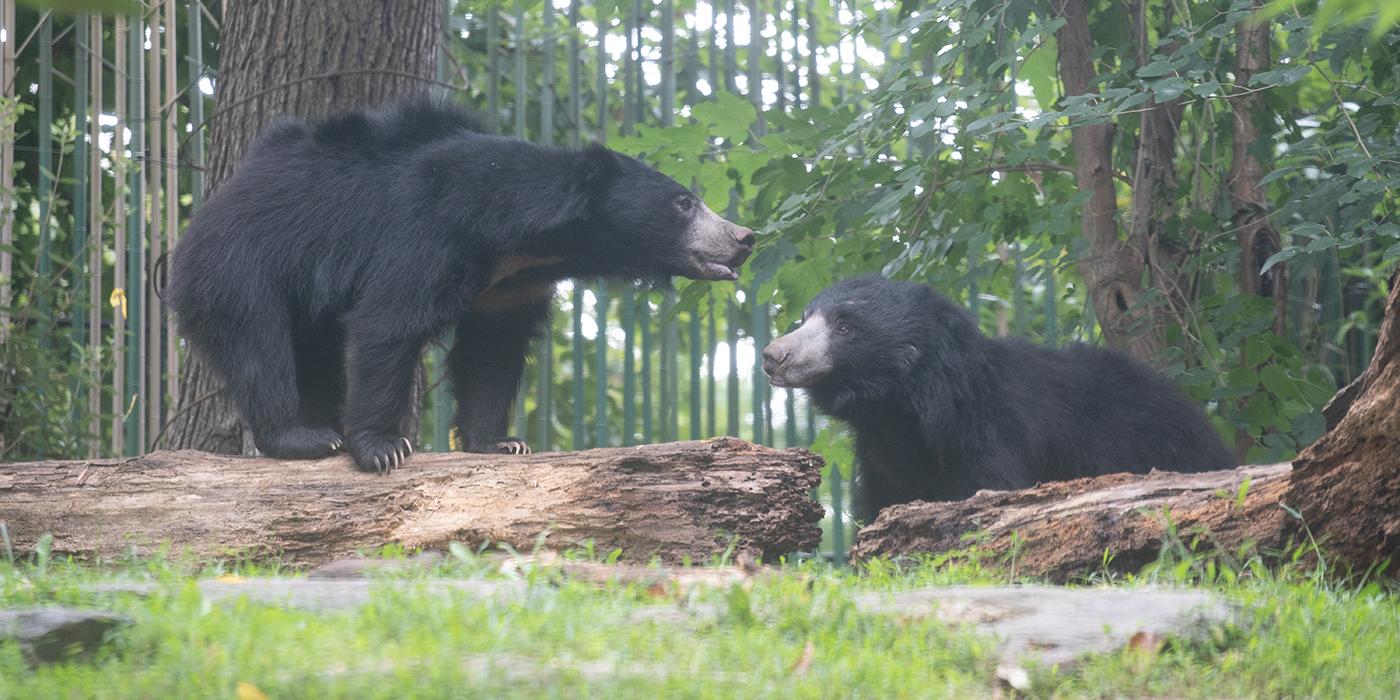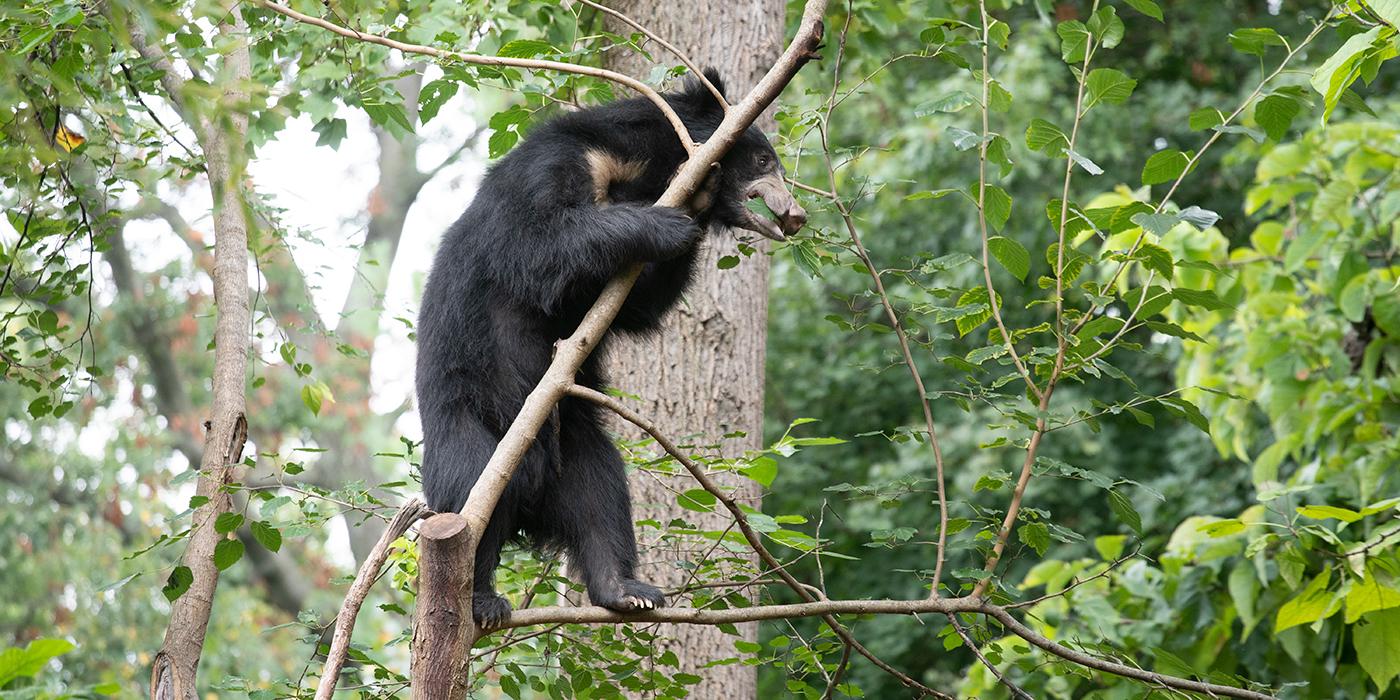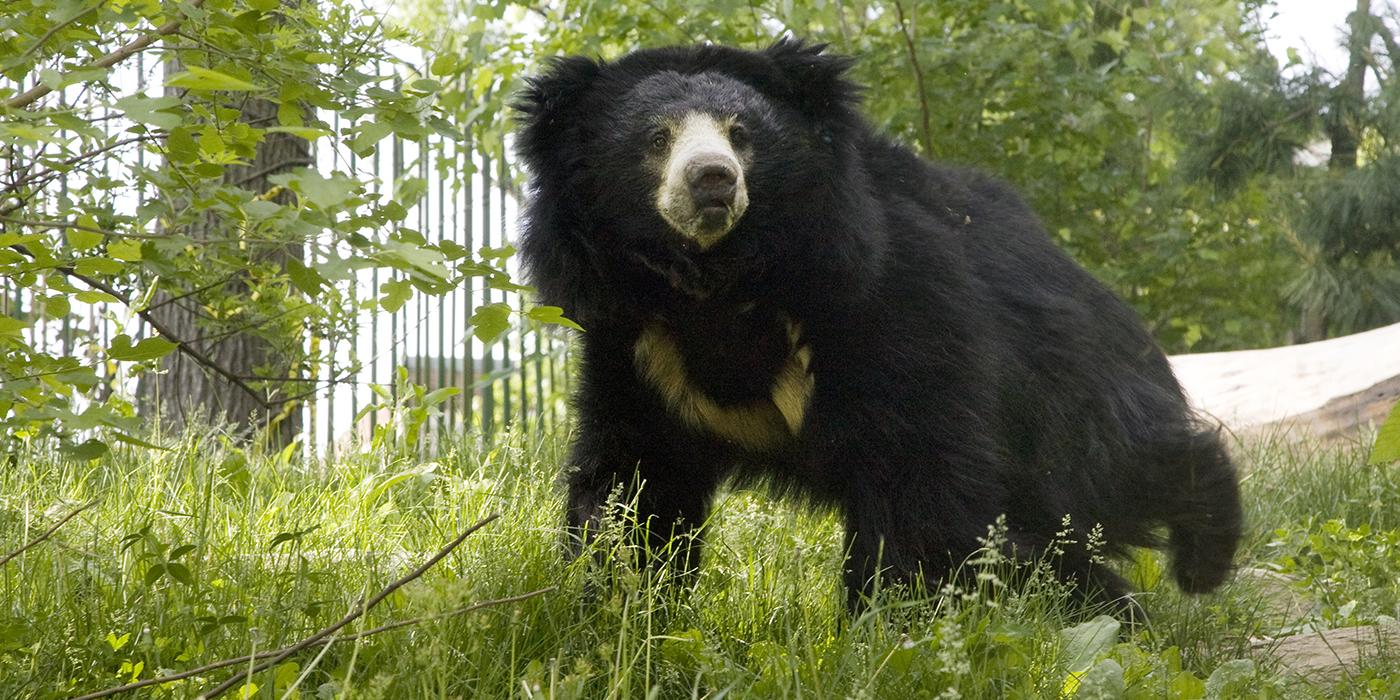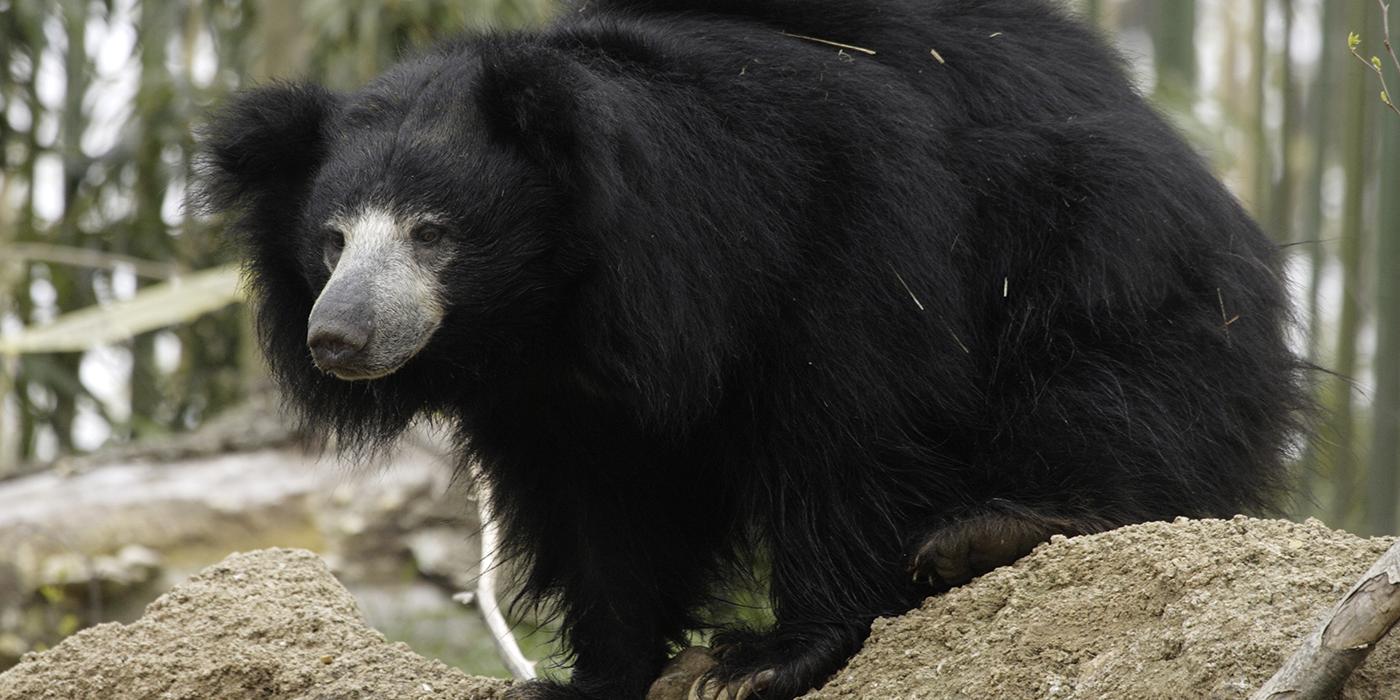Physical Description
Sloth bears have shaggy, dusty-black coats; pale, short-haired muzzles; and long, curved claws which they use to excavate termites and ants. A cream-colored “V” or “Y” shape usually marks their chests. Their shaggy fur does not have an undercoat, so it keeps them relatively cool in their native, warm climate and protects them from tropical insects. Sloth bears' nostrils can close completely, protecting the animals from dust or insects when raiding termite nests or beehives. They have a keen sense of smell, as well as near-sight similar to that of humans.
Adult sloth bears are missing their top two front teeth (incisors), which enables them to suck up termites and other insects with ease. Due to their diet of insects and fruit, their premolars and molars are smaller than those of other bears, but they have large canines to use for defense. It is thought that their feet are turned inward to increase digging efficiency.
The first valid scientific description of this species was by George Shaw in 1791. He called it Ursine bradypus, ursine meaning bearlike and bradypus meaning slow foot. Bradypus is also the genus of three species of sloth. At the time, Shaw thought that the bear was related to a sloth. Time and additional specimens eventually revealed the true taxonomic relationships, but the confusing common name remains.
Size
Sloth bears grow 5 to 6 feet (1.5 to 2 meters) long, stand 2 to 3 feet (0.5 to 1 meters) high at the shoulder, and weigh, on average, 200 to 300 pounds (90 to 140 kilograms).
Native Habitat
Sloth bears live in a variety of dry and moist forests and in some tall grasslands, where boulders, scattered shrubs and trees provide shelter. Their range includes India, Sri Lanka and southern Nepal. Historically, sloth bears have also been reported in Bangladesh and Bhutan, but it is unclear whether sloth bears are still present in the wild of these countries. They are currently considered extirpated, or no longer present, in Bangladesh and may also be absent from Bhutan.
Communication
Sloth bears are noisy, busy animals. They grunt and snort as they pull down branches to get fruit, dig for termites and ants, or snuffle under debris for grubs and beetles.
If threatened, they will stand on two legs, brandishing their clawed forepaws as weapons. Their large canines are used for defense against tigers. Other potential predators include jackals, wild dogs, wolves, leopards and other Asian bear species.
Food/Eating Habits
As animals who consume termites and ants, sloth bears are considered myrmecophagous. When trees are in fruit, usually during the monsoon season, sloth bears dine on mango, fig, ebony and other fruits, as well as on flowers.
Termites, dug out of their cement-hard nest mounds, and some ants are year-round staples. During non-fruiting season, insects constitute 95 percent of a sloth bear's diet. Sloth bears climb trees and knock down honeycombs, later collecting the honey from the forest floor. Beetles, grubs and other insects round out their diet. During food shortages, sloth bears will eat carrion. They also sometimes raid farm crops.
The Smithsonian's National Zoo's sloth bears eat a dry-food mixture designed for omnivores, plus fruits and vegetables, such as apples, sweet potatoes and grapes. At the Zoo, they are offered food at least three times daily: a large morning meal, a large evening meal and one or more snacks throughout the day. They also receive treats as enrichment, such as mealworms, crickets, nuts, coconut and honey.
Sleep Habits
These bears adapt their sleep-wake cycle to their environment and may be on a nocturnal, diurnal or crepuscular schedule depending on how many other bears, people or predators share their habitat. In protected areas, for example, sloth bears may be more active during the day. Sloth bears are typically active for about eight to 14 hours each day, and they do not hibernate. At the Zoo, they tend to keep a crepuscular schedule, meaning they are active in both the morning and evening but sleep midday and overnight.
Social Structure
Sloth bears are considered solitary, although they are occasionally seen in groups when resources are plentiful.
Reproduction and Development
In India, sloth bears breed in late spring to early summer. In Sri Lanka, however, there is no seasonality to sloth bear breeding. Mating occurs over several days to weeks and is very noisy.
While embryonic development takes approximately two months, gestation lasts four to seven months due to delayed implantation. In the weeks to months before a birth, the female may exhibit "denning" behavior. She digs a den or prepares space in a cave. She may become less interactive, or easily agitated, disinterested in food, defend the cubbing area and sleep more. These behaviors, correlated with hormonal changes, may occur even if the bear is experiencing a pseudopregnancy.
In the North American zoo population, births generally occur in late December to early January. One or two cubs (rarely three) are born in each litter in an underground den. They are born weighing about 1 pound (2 kilograms), open their eyes at about 2 to 3 weeks old and start to "walk" around 4 weeks. Cubs will nurse for about a year. After emerging from the den at around 9 to 12 weeks, cubs stay with their mother for approximately two to three years before heading off on their own --a long time in comparison to other bears. Sloth bears are the only bears to routinely carry their young on their backs as a primary mode of transportation; the cub clings to the extra shag of fur ("saddle") on the mother's back until it is 6 to 9 months old. Many other animals that primarily consume ants also carry their young on their backs.
Sloth bears are sexually mature at age 3, but are rarely mothers until later in life. They breed once every three years, more often if they have not given birth or have lost their cubs. Sloth bears exhibit low fecundity and high infant mortality — only about fifty percent of cubs survive.
Conservation Efforts
About 20,000 or fewer total sloth bears remain in the wild. However, no reliable large-scale population survey has been conducted. It is estimated that their population has declined by 30 to 49 percent in the last 30 years primarily due to habitat loss, but also because of poaching for parts, capture for trade and elimination as pests. Habitat is being transformed into human settlements, agriculture, plantations of teak and eucalyptus, and fuel wood and timber.
Once abundant, sloth bears have steadily lost ground due to habitat destruction and fragmentation, hunting and capture. Their world was very different 100 years ago; extensive habitat remained, human settlements were scattered and relatively few bears were hunted. Today, they inhabit one of the world's most crowded regions. Poachers kill bears to harvest their gall bladders and other parts for use in traditional Asian medicine.
The bile from their gall bladders is used in shampoo, eye drops, wine and medicine thought to cure liver disease and heart disease, improve eyesight and decrease high blood pressure. Bear bile sells on the black market at $2 million for 5 kilograms. The same substance, ursodeoxycholic acid, can be produced in the laboratory, and this synthetic version has proven to be a safer and more humane alternative for medical use.
Other sloth bears are captured for use as sideshow animals called "dancing bears." Until recently, approximately 100 cubs were taken from the wild annually for this purpose. In the process of poaching the cubs, the mother bear is killed. The cubs' teeth are then removed, and a metal ring is inserted into their muzzle with a rope tied to the end. When the rope is pulled, the bear stands up in pain and "dances." Despite being banned since 1972, this practice was difficult to control, because the dancing bears were the primary source of income for India's Kalandar tribe.
Today, most of the dancing bears have been rescued thanks to organizations like Wildlife SOS and WSPA-Wildlife Trust of India. These organizations provide education and career training for tribe members in exchange for giving up their bears and agreeing to never again poach wildlife, thus ensuring a better life for both the humans and the bears. This practice of capturing sloth bears to be used as dancing bears may still take place in neighboring countries.
In Pakistan, some people participate in "bear-baiting," the practice of having bears fight dogs. Sloth bears are poached from India and smuggled over the border for this practice. Farmers also sometimes kill bears that raid their sugarcane or cornfields. Sloth bears are now common only in parks and other remaining national forests. Strict protection of both bears and their forest and grassland ecosystems is their best hope for their future.
Zoo scientists have engaged in a wide-ranging set of studies in support of the conservation of endangered sloth bears in the wild. As far back as the early 1970s, they studied sloth bears in the wild in Nepal. Fifteen years later, a second team of Smithsonian research associates took up the challenge.
Sustaining threatened wild sloth bear populations can be achieved only with a comprehensive understanding of their ecological and behavioral needs. Currently, Zoo scientists are also studying the behavior, welfare and cognitive abilities of sloth bears in human care.
Help this Species
Practice ecotourism by being an advocate for the environment when you’re on vacation. During your travels, support, visit or volunteer with organizations that protect wildlife. Shop smart too! Avoid buying products made from animals, which could support poaching and the illegal wildlife trade.
Support organizations like the Smithsonian’s National Zoo and Conservation Biology Institute that research better ways to protect and care for this animal and other endangered species. Consider donating your time, money or goods.
Are you a student? Did you love what you learned about this animal? Make it the topic of your next school project, or start a conservation club at your school. You'll learn even more and share the importance of saving species with classmates and teachers, too.
Meet the Animals
Asia Trail is home to two male sloth bears, named Niko and Deemak, and a female named Vicki.
Smithsonian's National Zoo and Conservation Biology Institute. (n.d.). Sloth bear. Retrieved December 23, 2025, from https://nationalzoo.si.edu/animals/sloth-bear
